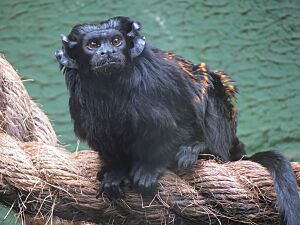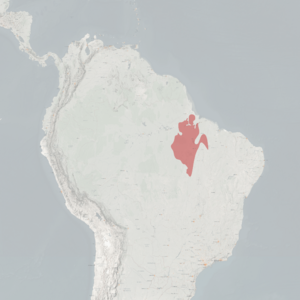Black tamarin facts for kids
Quick facts for kids Black tamarin |
|
|---|---|
 |
|
| Conservation status | |
| Scientific classification | |
| Genus: |
Saguinus
|
| Species: |
niger
|
 |
|
| Range of the Western Black-handed Tamarin | |
The black tamarin (Saguinus niger), also called the western black-handed tamarin, is a small monkey. It lives only in Brazil.
Contents
What is a Black Tamarin?
Black tamarins are some of the smallest primates. They weigh about 500 grams, which is like a small bag of sugar. Their back legs are longer than their front legs. They have claws on all their fingers and toes, except for their big toe.
Their faces usually don't have much hair. Their fur is mostly blackish-brown. They might have lighter marks on their backs. They look a bit like the golden-handed tamarin. But black tamarins do not have golden-orange feet and hands.
Where Do Black Tamarins Live?
Black tamarins live in the state of Pará, Brazil. Their home is bordered by big rivers. These include the Amazon River to the north and the Tocantins River to the east. The Xingu River is to the west. Recently, they have also been seen further south in Mato Grosso.
These tamarins usually live in forests. They prefer forests where trees lose some leaves, making it easier to find food. Thick plants also give them cover from animals that hunt them.
Sadly, many forests in eastern Brazil are being cut down. Because of this, black tamarins often live in small, broken-up forest areas. Even though much of the forest roof (canopy) is gone, they can still move around. They are most active in the lower and middle parts of the forest, about 5 to 15 meters high.
What Do Black Tamarins Eat?
Black tamarins spend a lot of time looking for food. They mostly stay in the trees and rarely go to the ground. Their main food is fruit.
During the dry season (November to January), fruit is harder to find. So, they also eat insects like grasshoppers and crickets. They also eat gum from a tree called Parkia pendula. Even in the dry season, some fruits are still available.
In the wet season, over 90 percent of their diet is fruit. They eat fruit from many different trees. When they eat fruit, they swallow the seeds. Later, they poop out these seeds. This helps new trees grow and keeps the forests healthy. This is very important because forests are always threatened by logging.
Who Hunts Black Tamarins?
Because black tamarins are small, many animals hunt them. Their predators include:
These cats are very good at hunting in trees. To stay safe, black tamarins climb into any tree or thick group of leaves. They also sleep together in groups at night. This helps them stay safe while resting.
Their social groups are also a big help against predators. While they look for food, each tamarin keeps an eye out. If they see danger, they make calls to warn their group. Black tamarins usually run away from predators. A single tamarin would not be able to find food and watch for predators safely by itself. This is why living in a group is so important for their survival.
How Do Black Tamarins Have Babies?
Tamarins usually live in family groups. These groups can have 4 to 15 members. In most tamarin groups, only one female has babies. This main female stops other females in her group from having babies.
When a young female tamarin grows up, she has two choices. She can either find a new group or stay with her family. If she stays, she might become the main female one day. If not, she might not be able to have babies.
Raising the Young
All adult black tamarins help raise the young. This includes members of the group who are not having babies themselves. They all work together to find enough food for the baby and young tamarins.
Unlike many other primate groups, black tamarins share a lot of food with their young. If a group is very big, the male who is having babies might spend less time with his own young. This is because everyone in the group helps out. Sometimes, if there is enough food, or if the main female is getting older, more than one female in a group might have babies.
Baby tamarins have been seen in early January and mid-July. Black tamarins usually have twins. But sometimes they can have 2 to 4 babies at once. Having triplets or quadruplets usually only happens when they are in zoos. Babies grow very fast. They can be independent within five months. Females can get pregnant again just a few weeks after giving birth.
Why Are Black Tamarins Vulnerable?
The black tamarin is listed as a vulnerable species. This means their population has gone down by 30% in the last 18 years. They might become endangered if we don't help them.
The biggest threat to black tamarins is losing their homes. Logging has cut down a lot of their original forest. This means less food and fewer safe places from predators. However, black tamarins are good at finding food in different types of forests. They can live in original forests, new forests, and even forests that have been logged. This gives them more places to live.
Some black tamarin groups live in special reserves where logging is not allowed. These include the Gurupi Biological Reserve, Tapirapé Biological Reserve, and Caxiuanã National Forest. In other areas, many black tamarins can only survive in small forest patches on private land.


